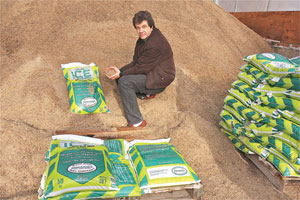Why is Milwaukee pouring cheese brine on roads, while Morton Arboretum in Illinois is using beet juice?
One of the side effects of frigid cold and snow is the need to keep roads clear and unfortunately, the products used end up in rivers and streams, making them noticeably saltier.
That’s because salt (and sand) are cheap and effective to spread on roads, but after billions of pounds have been applied during the winter for decades, it’s threatening wildlife and groundwater supplies.
An incredible 35 billion pounds a year of salt are applied each year. Used since the 1940s, when about 617 million pounds were spread, the volume has increased significantly each decade.
New research shows that rock salt (sodium chloride) gets into rivers making them toxic for most of the year. Chloride levels can be 10-15 times higher than fish, amphibians and other life can withstand.
Many organisms that are sensitive to chloride probably just aren’t there anymore, says Steve Corsi with the U.S. Geological Survey, which conducted the research.
“Road-side aquatic ecosystems in North America are annually polluted with millions of tons of road deicing salts, which threaten the survival of amphibians which live and breed in these habitats,” according to research at Utah State University, reports EcoWatch. Researchers found that newts develop severe deformities, such as shrunken heads and missing tails, and salamander eggs don’t develop normally.
And once salt seeps into groundwater it can contaminate drinking water supplies. “Even if they quit applying salt now, it would take decades for it to be removed from the system,” says Sujay Kaushal, who studies road salt in Northeast streams at the University of Maryland.
It also causes damage to soil, plants and trees. Salt enters the soil, often by bouncing off roads, and literally dries out landscape plants. Often the damage isn’t visible until spring or even years later.
Beet Juice at Morton Arboretum
The 1700-acre Morton Arboretum uses beet juice combined with rock salt to keep its 16 miles of roads and 9 miles of trails clear. They find it does a better job that salt alone and causes less harm to the environment
and the more than 190,000 plants there.
The product, called Ice Bite, is made on site. Beet
juice is effective because it prevents water from freezing
down to -20 degrees, as opposed to salt, which prevents freezing at 5 degrees or higher. Adding beet juice also cuts the amount of salt that bounces off roads by 5-30%. That reduces the amount of salt that’s needed to clear roads while keeping it away from ecosystems. Using beet juice, Morton Arboretum has been able to cut salt use by nine times, they say.
The Arboretum likes the beet juice combination so much that they’ve invested in sprayers, plows, and blowers that
are all customized to work with Ice Bite.
“We spend a good amount of time mechanically removing snow
and the substance makes the task easier,” says PJ Smith, who manages the Arboretum.
Toronto and many other municipalities now use beet juice.
East End Organics in Riverhead, NY is the exclusive retailer of beet juice ice melts in the Northeast:

Cheese Brine in Milwaukee
In nearby Wisconsin, Milwaukee is experimenting with an abundant waste product, cheese brine, a byproduct of its biggest industry, cheese-making from dairy.
As in beet juice, much less salt is needed if you use cheese brine, especially if you spread salty cheeses like provolone or mozzarella! It also reuses the brine, which is otherwise thrown away.
Apparently there’s no smell or rodent problem from the cheese-covered streets as officials feared and it has the potential to save cheese-makers lots
of money on disposal costs.
F & A Dairy Products now saves about $20,000 a year in garbage hauling costs by donating the excess liquid to a bunch of municipalities that cart it away, including Milwaukee, its wastewater manager Chuck Engdahl, told the NY Times.
Polk County, which has been using cheese brine on highways since 2009, has saved an estimated $40,000 in rock salt.
What else can municipalities do to prevent salt from washing into and polluting streams and soils?
When roads are re-engineered, engineers need to take runoff into account, and where roads are near waterways, we need to keep wetlands and vegetation in tact to prevent salt from reaching steams.
“We need to ask ourselves if we should really be putting more highways, parking lots and houses right on top of rivers,” says Kaushal of University of Maryland.
Here’s the US Geological Survey study, "The Increasing Impact of Road Salt, Long-Term Chloride Trends in Streams of the Northern US:
